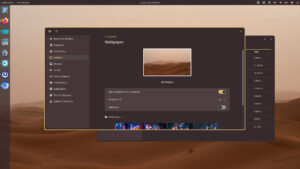Do you want to try something completely different? Here are five Linux distros that are most likely different than anything you’ve taken for a spin.
One of the complaints we hear sometimes about the plethora of GNU/Linux distributions is that they’re all “cookie cutters.” One is just like the other, we’re told, so why have so many versions of the same thing? For starters, except for a couple of rare instances, no two Linux distros are exactly alike, not even when they start with the same base. The most obvious example here would be Ubuntu, which although based on Debian, offers the user an experience completely different from the parent distro. Likewise, Linux Mint is built with Ubuntu under the hood, but as many Mint users will attest, the distro is hardly just a rebranded *buntu.

Stali: Here’s a distro that’s taking an approach I’m reasonably certain many have considered but haven’t attempted. Stali does away with dynamically linked library files by including any needed shared library routines directly in the program. Project head Anselm R. Garbe, who also developed the DWM windows manager, says the benefits to this approach are numerous. To begin with, it all but does away with “dependency hell” because there aren’t any dependencies. It also means packages can be installed without a package manager. Garbe claims the system runs much faster, as less RAM is being used (though there are no benchmarks yet). It’s also lightweight: The ISO image for the distro’s recent first release weighs in at only 34 MB. It also doesn’t use systemd, which should make a few folks happy. Instead, it uses its own sinit utility.
NixOS: This is another distro that takes a completely different approach than the norm — although it’s definitely not for the faint of heart. With NixOS the entire operating system is built by the Nix package manager using a purely functional language, which makes the process of upgrading and the like completely safe. Because no files are overwritten, even if an upgrade should fail halfway through the process, the user isn’t left with a broken and useless system. In fact, in most cases it will be able to boot not only into the old configuration, exactly as it was, but into a workable version of the new “broken” configuration as well. Systems that have been reconfigured or upgraded and then prove to be unsatisfactory can be easily rolled back in mere minutes, again because nothing is overwritten. The operating system is built with DevOps in mind and comes with tools dedicated to deployment tasks.
Kali Linux: You might call this the CSI of Linux distros, as it’s designed for digital forensics and penetration testing. Based on Debian Jesse, Kali Linux comes with over 300 penetration-testing programs preinstalled. It’s also developed and maintained in an extremely secure environment. Only a few known and trusted people are allowed to commit code, and every package is signed by the developer. The distro is funded and maintained by Offensive Security.
Tiny Core Linux When most people think of a small Linux distro they think either of Puppy Linux, which weighs in at about 210 MB, or Damn Small Linux which is pretty damn small at 50 MB. Wanna get smaller than that? How about Tiny Core Linux, which only takes up 16 MB, complete with a graphical interface and able to get online with a wired connection. Wanna get smaller than that? There’s the 11 MB Core version that out-of-the box has no graphical interface. Hardware support for both versions is iffy. Oh, there is a gigantic 106 MB version — “an installation image and not the distribution” — called Core Plus that has some added functions, like Wi-Fi.
RLSD (Retro Linux-libre Software Distribution): Like Stali, RLSD uses statically linked binaries and has a monolithic architecture. It’s also text based and comes with a wide assortment of command line tools. It comes in three versions — tiny, big and huge — with the largest weighing in at 69 MB. It also comes with a baked-in firewall and numerous other security enhancements. Oh, it’s said to boot to the command prompt in about three seconds. The user, called “boss,” always runs as root. It also features mouse based copy/paste and a randomly generated console color scheme.
Christine Hall has been a journalist since 1971. In 2001, she began writing a weekly consumer computer column and started covering Linux and FOSS in 2002 after making the switch to GNU/Linux. Follow her on Twitter: @BrideOfLinux






IMO a better list would be
Ubuntu
Elementary OS
Zorin OS
Antergos
UbuntuBSD
@Bubba
UbuntuBSD isn’t a Linux distro.
I have been MS free for more than ten years. However, MS got the GUI right. I am a KDE desktop user because it closely resembles XP. So, until technology progresses beyond the pphysical monitor, mouse and keyboard, this article is MOOT. OOh, and yes, I have painfully authored this post on an AAndroid smart phone, such as a monk would do, whipping his back and drawing blood in repent.
We are using TinyCore to “upgrade” the OS of some very old ThinClients here, and i have to say that this guy is reeeeeeeeally thin and their community pretty awesome. They helped me a lot when i had to compile and package some things;
Actually, statically linked binaries would mean *more* RAM usage. Shared libraries are shared, so they’re only loaded into RAM once.
May very well not feel it, but it is achievable
to truly save hundreds and even thousands of bucks per year
through the use of simple deals.
@David,
> “Actually, statically linked binaries would mean *more* RAM usage.”
Not necessarily. Static linking can link just the portion of the library *actually called*. Often this may just be a function or two, thus avoiding the need to load then entire (and possibly huge) library into memory.
But doesn’t some library specifically required to be dynamicaly linked due to licensing? This would mean that some application can’t be installed on those distro.
@Alain,
The only license that springs to mind is LGPL.
LGPL doesn’t require dynamic linking. It gives you a choice:
“…
d) Do one of the following:
0) Convey the Minimal Corresponding Source under the terms of this License, and the Corresponding Application Code in a form suitable for, and under terms that permit, the user to recombine or relink the Application with a modified version of the Linked Version to produce a modified Combined Work, in the manner specified by section 6 of the GNU GPL for conveying Corresponding Source.
1) Use a suitable shared library mechanism for linking with the Library. A suitable mechanism is one that (a) uses at run time a copy of the Library already present on the user’s computer system, and (b) will operate properly with a modified version of the Library that is interface-compatible with the Linked Version.
”
This means it’s only a problem if you are distributing a closed source application that links to an LGPL library.
Answer: Use open source and your problems go away.
well written article. thanks for sharing